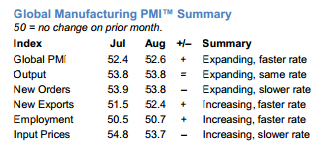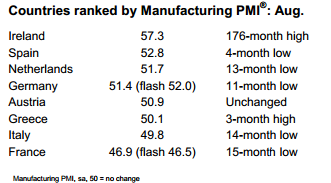Economy

Global Manufacturing Conditions Stagnant in August
Written by Sandy Williams
September 2, 2014
Global manufacturing conditions were relatively unchanged in August, increasing to 52.6 on the JP Morgan Global Manufacturing PMI from 52.4 in July.
The US continued to show strong domestic and foreign demand. The Eurozone and the UK weakened in August with the Eurozone registering its lowest PMI since July 2013. Japan rebounded while manufacturing conditions were flat in China, South Korea and Turkey.

Input costs rose at the slowest pace in three months while selling prices showed little change. Employment gains were strong in the US, Canada and Ireland and elsewhere with job cuts reported in China, Germany, France, Italy, Greece, Russia, India, Brazil and Indonesia.
Eurozone

Russia
Output grew for the third consecutive month although at a slower rate in August. The HSBC Russia Manufacturing PMI registered 51.0 in August, unchanged from the previous month. The increase in new orders is attributed to domestic demand as exports continued to decline.
“Overall, Russian manufacturing holds up surprisingly well against various headwinds. In this respect, the import substitution policy that the government has made a priority can provide support to the manufacturing sector in the short-term,”said Alexander Morozov, Chief Economist (Russia and CIS) at HSBC. “However, the overall impact of import substitution on the Russian economy appears to be negative.”
China
Manufacturing conditions improve only slightly in August as output and new orders both slowed. The HSBC China Manufacturing PMI registered 50.2, down from 50.1 in August.
“The HSBC China Manufacturing PMI eased slightly to 50.2 in the final reading for August from the flash reading of 50.3,”said Hongbin Qu, Chief Economist, China & Co-Head of Asian Economic Research at HSBC. “The revisions were mixed, with upward revision to the new export orders and output sub-indices but downward revisions to the employment and input prices indices. Although external demand showed improvement, domestic demand looked more subdued. Overall, the manufacturing sector still expanded in August, but at a slower pace compared to previous months. We think the economy still faces considerable downside risks to growth in the second half of the year, which warrant further policy easing to ensure a steady growth recovery.”
Canada
The RBC Canadian Manufacturing PMI registered 54.8 in August up from 54.3. Conditions were reported as robust across the manufacturing sector with gain in production, new business growth, and job creation. “We expect that Canadian manufacturers will continue to directly benefit from the strengthening U.S. economy, which has made and will continue to make positive strides,” said Craig Wright, senior vice-president and chief economist, RBC.
Mexico
Production and employment picked up in August. Increased production led to higher input buying during the month. Inventory levels increased as firms dealt with transportation delays and lengthening supplier delivery times. The headline PMI rose to 52.1 in August from 51.5 in July supported by export demand.

Sandy Williams
Read more from Sandy WilliamsLatest in Economy

Steel groups welcome passage of budget bill
Steel trade groups praised the passage of the Big Beautiful Bill (BBB) in Congress on Thursday.

Industry groups praise Senate for passing tax and budget bill
The Steel Manufacturers Association and the American Iron and Steel Institute applauded the tax provisions included in the Senate's tax and budget reconciliation bill.

Chicago PMI dips 0.1 points in June
The Chicago Purchasing Managers Index (PMI) slipped 0.1 points to 40.4 points, in June.

Multi-family pullback drives housing starts to 5-year low in May
US housing starts tumbled in May to a five-year low, according to figures recently released by the US Census Bureau.

Architecture firms still struggling, ABI data shows
Architecture firms reported a modest improvement in billings through May, yet business conditions remained soft, according to the latest Architecture Billings Index (ABI) release from the American Institute of Architects (AIA) and Deltek.
